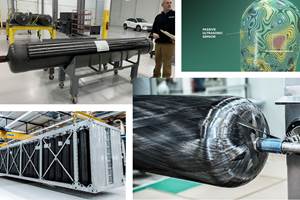Recognizing composites industry inventors
Inventors and their inventions are essential to keeping the composites industry vibrant and ever improving.
Perusing my bookshelves recently, I came upon a book I’d read more than 20 years ago, titled And Suddenly the Inventor Appeared, by Genrich Altschuller, a Russian inventor. It’s a treatise on TRIZ, the theory of inventive problem solving. Its premise is that any invention is ultimately the result of the application of physics, although the path to the solution is not always the obvious one.
The world is full of famous inventors (and inventions), going back, at least, to Archimedes, with his conveying screw, and his use of buoyancy to derive material densities (per legend, an idea he conjured while bathing). Inventions change things. Some inventions change everything. Johannes Gutenberg, who introduced moveable type for printing presses, and Leonardo da Vinci’s numerous inventions ushered in the modern period of human history. The creation of the patent system provided legal protection to inventors that afforded them the time and opportunity to monetize their ideas.
The industrial revolution gave us Watt, Whitney, Deere, Benz, Daimler, Ford, Tesla, Bell, Firestone and perhaps the world’s most famous inventor, Thomas Edison. Referring to his deliberate method of discovery, Edison famously claimed, “Genius is 1% inspiration and 99% perspiration,” to dispel the notion that inventions are mainly the result of accidents or are stumbled upon by those pursing other goals. In 1947, William Shockley’s invention of the transistor and the commercialization effort that followed in California is believed to be the genesis of today’s Silicon Valley.
The composites world is not short of well-known inventors, starting with Leo Baekeland, the creator of the first synthetic resin, phenolic. Trademarked as Bakelite, thermosetting phenolics quickly found numerous uses in neat form, but also as a binder for mineral and fibrous fillers, both discontinuous and continuous. Phenolic composites are used extensively today, in aircraft interiors, oil and gas applications, fire-resistant building and train panels, and high-voltage electrical components.
The first patent for resin transfer molding (RTM), issued in 1950, is often referred to as the Marco Process, assigned to Marco Chemicals in New Jersey by the lesser known inventor Irving Muscat. The process and patent are often cited in later patents for all sorts of resin infusion techniques, including variations of vacuum-assisted RTM (VARTM), such as the Seeman Composite Resin Infusion Process (SCRIMP), patented by Bill Seeman. Robert Morrison, founder of Morrison Molded Fiber Glass, has been involved in many innovations, none more famous than the press-molded composite body panels for the pioneering 1953 Chevrolet Corvette.
The most lauded inventor in the composites industry is probably the late Brandt Goldsworthy, who was granted well over 50 patents for composites processes, including straight and curved pultrusions, CNC filament winding and tape placement, among others. From his inventions, and the companies he founded or helped found, has sprung a robust composites industry built on lower cost, automated manufacturing.
I’ve been fortunate during my career in composites to come across numerous inventors. Some are itinerant tinkerers, working out of a garage or shed — like the founders of Hewlett Packard and Apple. Others have the advantage of tinkering inside corporate laboratories. Some employ deliberate methodologies that would make Edison proud. Others simply reach out experimentally, relying on the random epiphany for that “Eureka!” moment. For example, the inventor of the Quickstep curing process, a floating, balanced pressure, liquid heating and cooling process, claims to have come up with the idea while sitting in his bathtub — his own Archimedes moment!
My favorites have been the serial inventors, those with multiple ideas that have reached various states of commercialization. One friend of mine in the US has come up with novel ways to recycle thermosets, developed metals that heat and cool molds rapidly, resins for infusing (and improving the strength of) 3D printed powder structures, and very high-temperature and fire-resistant thermoset resins, among other creations. A friend in the UK, whom I consider one of the best I’ve met at thinking outside the box, has developed a number of lightweight vehicle platforms, a patented method of metalizing carbon composites, and low-cost methods for fabricating large, structural sandwich panels, using a mix of virgin and recycled carbon fibers. Not only are both serial inventors, they are also serial entrepreneurs. I know many others just like them, who open my eyes to what is possible.
What they, and others like them are doing, is essential to keeping the composites industry vibrant and ever improving. Not every invention or innovation is a commercial smash, but that should not limit us from encouraging novel ideas, no matter how they are conceived or how improbable they might seem.
Related Content
Plant tour: Middle River Aerostructure Systems, Baltimore, Md., U.S.
The historic Martin Aircraft factory is advancing digitized automation for more sustainable production of composite aerostructures.
Read MoreNovel composite technology replaces welded joints in tubular structures
The Tree Composites TC-joint replaces traditional welding in jacket foundations for offshore wind turbine generator applications, advancing the world’s quest for fast, sustainable energy deployment.
Read MorePlant tour: Arris Composites, Berkeley, Calif., U.S.
The creator of Additive Molding is leveraging automation and thermoplastics to provide high-volume, high-quality, sustainable composites manufacturing services.
Read MoreHexagon Purus Westminster: Experience, growth, new developments in hydrogen storage
Hexagon Purus scales production of Type 4 composite tanks, discusses growth, recyclability, sensors and carbon fiber supply and sustainability.
Read MoreRead Next
Developing bonded composite repair for ships, offshore units
Bureau Veritas and industry partners issue guidelines and pave the way for certification via StrengthBond Offshore project.
Read More“Structured air” TPS safeguards composite structures
Powered by an 85% air/15% pure polyimide aerogel, Blueshift’s novel material system protects structures during transient thermal events from -200°C to beyond 2400°C for rockets, battery boxes and more.
Read MoreVIDEO: High-volume processing for fiberglass components
Cannon Ergos, a company specializing in high-ton presses and equipment for composites fabrication and plastics processing, displayed automotive and industrial components at CAMX 2024.
Read More













.jpg;maxWidth=300;quality=90)







